Experimental Evaluation of the Role of Ecologically-Relevant Hosts and Vectors in Japanese Encephalitis Virus Genotype Displacement
Abstract
1. Introduction
2. Materials and Methods
2.1. Ethics Statement
2.2. Cells and Viruses
2.3. In Vitro Growth Curve Kinetics
2.4. Animal Experiments
2.5. Mosquito Experiments
2.6. Vector Competence and Extrinsic Incubation Period
2.7. Virus Titration and Serology
2.8. Data Analysis
3. Results
3.1. In Vitro Growth Kinetics
3.2. Clinical Signs in Ducklings Inoculated with JEV
3.3. Replication of JEV in Ducklings
3.4. Shedding of JEV from Ducklings
3.5. Antibody Response to JEV in Ducklings
3.6. Vector Competence and Extrinsic Incubation Period
4. Discussion
Author Contributions
Funding
Acknowledgments
Conflicts of Interest
References
- Chambers, T.J.; Hahn, C.S.; Galler, R.; Rice, C.M. Flavivirus genome organization, expression, and replication. Annu. Rev. Microbiol. 1990, 44, 649–688. [Google Scholar] [CrossRef]
- Lindenbach, B.D.; Rice, C.M. Molecular biology of flaviviruses. Adv. Virus Res. 2003, 59, 23–61. [Google Scholar] [PubMed]
- Lord, J.S.; Gurley, E.S.; Pulliam, J.R. Rethinking Japanese Encephalitis Virus Transmission: A Framework for Implicating Host and Vector Species. PLoS Negl. Trop. Dis. 2015, 9, e0004074. [Google Scholar] [CrossRef] [PubMed]
- Mackenzie, J.S.; Gubler, D.J.; Petersen, L.R. Emerging flaviviruses: The spread and resurgence of Japanese encephalitis, West Nile and dengue viruses. Nat. Med. 2004, 10 (Suppl. 12), S98–S109. [Google Scholar] [CrossRef] [PubMed]
- Van den Hurk, A.F.; Ritchie, S.A.; Mackenzie, J.S. Ecology and geographical expansion of Japanese encephalitis virus. Annu. Rev. Entomol. 2009, 54, 17–35. [Google Scholar] [CrossRef]
- Solomon, T.; Ni, H.; Beasley, D.W.; Ekkelenkamp, M.; Cardosa, M.J.; Barrett, A.D. Origin and evolution of Japanese encephalitis virus in southeast Asia. J. Virol. 2003, 77, 3091–3098. [Google Scholar] [CrossRef]
- Beasley, D.W.; Li, L.; Suderman, M.T.; Guirakhoo, F.; Trent, D.W.; Monath, T.P.; Shope, R.E.; Barrett, A.D. Protection against Japanese encephalitis virus strains representing four genotypes by passive transfer of sera raised against ChimeriVax-JE experimental vaccine. Vaccine 2004, 22, 3722–3726. [Google Scholar] [CrossRef] [PubMed]
- Campbell, G.L.; Hills, S.L.; Fischer, M.; Jacobson, J.A.; Hoke, C.H.; Hombach, J.M.; Marfin, A.A.; Solomon, T.; Tsai, T.F.; Tsu, V.D.; et al. Estimated global incidence of Japanese encephalitis: A systematic review. Bull. World Health Organ. 2011, 89, 766–774. [Google Scholar] [CrossRef]
- Pyke, A.T.; Williams, D.T.; Nisbet, D.J.; van den Hurk, A.F.; Taylor, C.T.; Johansen, C.A.; Macdonald, J.; Hall, R.A.; Simmons, R.J.; Mason, R.J.; et al. The appearance of a second genotype of Japanese encephalitis virus in the Australasian region. Am. J. Trop. Med. Hyg. 2001, 65, 747–753. [Google Scholar] [CrossRef]
- Jeffries, C.L.; Walker, T. The Potential Use of Wolbachia-Based Mosquito Biocontrol Strategies for Japanese Encephalitis. PLoS Negl. Trop. Dis. 2015, 9, e0003576. [Google Scholar] [CrossRef] [PubMed]
- Fischer, M.; Lindsey, N.; Staples, J.E.; Hills, S.; Centers for Disease, C.; Centers for Disease Control and Prevention. Japanese encephalitis vaccines: Recommendations of the Advisory Committee on Immunization Practices (ACIP). MMWR Recomm. Rep. 2010, 59, (RR-1). 1–27. [Google Scholar]
- Erlanger, T.E.; Weiss, S.; Keiser, J.; Utzinger, J.; Wiedenmayer, K. Past, present, and future of Japanese encephalitis. Emerg. Infect. Dis. 2009, 15, 1–7. [Google Scholar] [CrossRef] [PubMed]
- Han, N.; Adams, J.; Fang, W.; Liu, S.Q.; Rayner, S. Investigation of the genotype III to genotype I shift in Japanese encephalitis virus and the impact on human cases. Virol. Sin. 2015, 30, 277–289. [Google Scholar] [CrossRef]
- Chen, W.R.; Tesh, R.B.; Rico-Hesse, R. Genetic variation of Japanese encephalitis virus in nature. J. Gen. Virol. 1990, 71, 2915–2922. [Google Scholar] [CrossRef] [PubMed]
- Paranjpe, S.; Banerjee, K. Phylogenetic analysis of the envelope gene of Japanese encephalitis virus. Virus Res. 1996, 42, 107–117. [Google Scholar] [CrossRef]
- Williams, D.T.; Wang, L.F.; Daniels, P.W.; Mackenzie, J.S. Molecular characterization of the first Australian isolate of Japanese encephalitis virus, the FU strain. J. Gen. Virol. 2000, 81, 2471–2480. [Google Scholar] [CrossRef]
- Schuh, A.J.; Ward, M.J.; Brown, A.J.; Barrett, A.D. Phylogeography of Japanese encephalitis virus: Genotype is associated with climate. PLoS Negl. Trop. Dis. 2013, 7, e2411. [Google Scholar] [CrossRef]
- Ali, A.; Igarashi, A. Antigenic and genetic variations among Japanese encephalitis virus strains belonging to genotype 1. Microbiol. Immunol. 1997, 41, 241–252. [Google Scholar] [CrossRef]
- Wills, M.R.; Singh, B.K.; Debnath, N.C.; Barrett, A.D. Immunogenicity of wild-type and vaccine strains of Japanese encephalitis virus and the effect of haplotype restriction on murine immune responses. Vaccine 1993, 11, 761–766. [Google Scholar] [CrossRef]
- Erra, E.O.; Askling, H.H.; Yoksan, S.; Rombo, L.; Riutta, J.; Vene, S.; Lindquist, L.; Vapalahti, O.; Kantele, A. Cross-protection elicited by primary and booster vaccinations against Japanese encephalitis: A two-year follow-up study. Vaccine 2013, 32, 119–123. [Google Scholar] [CrossRef] [PubMed]
- Bonaparte, M.; Dweik, B.; Feroldi, E.; Meric, C.; Bouckenooghe, A.; Hildreth, S.; Hu, B.; Yoksan, S.; Boaz, M. Immune response to live-attenuated Japanese encephalitis vaccine (JE-CV) neutralizes Japanese encephalitis virus isolates from South-East Asia and India. BMC Infect. Dis. 2014, 14, 156. [Google Scholar] [CrossRef] [PubMed]
- Ye, Q.; Xu, Y.P.; Zhang, Y.; Li, X.F.; Wang, H.J.; Liu, Z.Y.; Li, S.H.; Liu, L.; Zhao, H.; Nian, Q.G.; et al. Genotype-specific neutralization determinants in envelope protein: Implications for the improvement of Japanese encephalitis vaccine. J. Gen. Virol. 2015, 96, 2165–2175. [Google Scholar] [CrossRef] [PubMed]
- Ricklin, M.E.; Garcia-Nicolas, O.; Brechbuhl, D.; Python, S.; Zumkehr, B.; Nougairede, A.; Charrel, R.N.; Posthaus, H.; Oevermann, A.; Summerfield, A. Vector-free transmission and persistence of Japanese encephalitis virus in pigs. Nat. Commun. 2016, 7, 10832. [Google Scholar] [CrossRef] [PubMed]
- Ma, S.P.; Yoshida, Y.; Makino, Y.; Tadano, M.; Ono, T.; Ogawa, M. Short report: A major genotype of Japanese encephalitis virus currently circulating in Japan. Am. J. Trop. Med. Hyg. 2003, 69, 151–154. [Google Scholar] [CrossRef] [PubMed]
- Nga, P.T.; del Carmen Parquet, M.; Cuong, V.D.; Ma, S.P.; Hasebe, F.; Inoue, S.; Makino, Y.; Takagi, M.; Nam, V.S.; Morita, K. Shift in Japanese encephalitis virus (JEV) genotype circulating in northern Vietnam: Implications for frequent introductions of JEV from Southeast Asia to East Asia. J. Gen. Virol. 2004, 85 Pt 6, 1625–1631. [Google Scholar] [CrossRef]
- Mohammed, M.A.; Galbraith, S.E.; Radford, A.D.; Dove, W.; Takasaki, T.; Kurane, I.; Solomon, T. Molecular phylogenetic and evolutionary analyses of Muar strain of Japanese encephalitis virus reveal it is the missing fifth genotype. Infect. Genet. Evol. 2011, 11, 855–862. [Google Scholar] [CrossRef]
- Sarkar, A.; Taraphdar, D.; Mukhopadhyay, S.K.; Chakrabarti, S.; Chatterjee, S. Molecular evidence for the occurrence of Japanese encephalitis virus genotype I and III infection associated with acute encephalitis in patients of West Bengal, India, 2010. Virol. J. 2012, 9, 271. [Google Scholar] [CrossRef]
- Schuh, A.J.; Ward, M.J.; Leigh Brown, A.J.; Barrett, A.D. Dynamics of the emergence and establishment of a newly dominant genotype of Japanese encephalitis virus throughout Asia. J. Virol. 2014, 88, 4522–4532. [Google Scholar] [CrossRef]
- Chen, Y.Y.; Fan, Y.C.; Tu, W.C.; Chang, R.Y.; Shih, C.C.; Lu, I.H.; Chien, M.S.; Lee, W.C.; Chen, T.H.; Chang, G.J.; et al. Japanese encephalitis virus genotype replacement, Taiwan, 2009–2010. Emerg. Infect. Dis. 2011, 17, 2354–2356. [Google Scholar] [CrossRef]
- Pan, X.L.; Liu, H.; Wang, H.Y.; Fu, S.H.; Liu, H.Z.; Zhang, H.L.; Li, M.H.; Gao, X.Y.; Wang, J.L.; Sun, X.H.; et al. Emergence of genotype I of Japanese encephalitis virus as the dominant genotype in Asia. J. Virol. 2011, 85, 9847–9853. [Google Scholar] [CrossRef]
- Fan, Y.C.; Lin, J.W.; Liao, S.Y.; Chen, J.M.; Chen, Y.Y.; Chiu, H.C.; Shih, C.C.; Chen, C.M.; Chang, R.Y.; King, C.C.; et al. Virulence of Japanese Encephalitis Virus Genotypes I and III, Taiwan. Emerg. Infect. Dis. 2017, 23, 1883–1886. [Google Scholar] [CrossRef]
- Ebel, G.D.; Carricaburu, J.; Young, D.; Bernard, K.A.; Kramer, L.D. Genetic and phenotypic variation of West Nile virus in New York, 2000–2003. Am. J. Trop. Med. Hyg. 2004, 71, 493–500. [Google Scholar] [CrossRef] [PubMed]
- Moudy, R.M.; Meola, M.A.; Morin, L.L.; Ebel, G.D.; Kramer, L.D. A newly emergent genotype of West Nile virus is transmitted earlier and more efficiently by Culex mosquitoes. Am. J. Trop. Med. Hyg. 2007, 77, 365–370. [Google Scholar] [CrossRef] [PubMed]
- Armstrong, P.M.; Rico-Hesse, R. Differential susceptibility of Aedes aegypti to infection by the American and Southeast Asian genotypes of dengue type 2 virus. Vector Borne Zoonotic Dis. 2001, 1, 159–168. [Google Scholar] [CrossRef] [PubMed]
- Hanley, K.A.; Nelson, J.T.; Schirtzinger, E.E.; Whitehead, S.S.; Hanson, C.T. Superior infectivity for mosquito vectors contributes to competitive displacement among strains of dengue virus. BMC Ecol. 2008, 8, 1. [Google Scholar] [CrossRef] [PubMed]
- Quiner, C.A.; Parameswaran, P.; Ciota, A.T.; Ehrbar, D.J.; Dodson, B.L.; Schlesinger, S.; Kramer, L.D.; Harris, E. Increased replicative fitness of a dengue virus 2 clade in native mosquitoes: Potential contribution to a clade replacement event in Nicaragua. J. Virol. 2014, 88, 13125–13134. [Google Scholar] [CrossRef] [PubMed]
- Do, L.P.; Bui, T.M.; Hasebe, F.; Morita, K.; Phan, N.T. Molecular epidemiology of Japanese encephalitis in northern Vietnam, 1964–2011: Genotype replacement. Virol. J. 2015, 12, 51. [Google Scholar] [CrossRef] [PubMed]
- Nabeshima, T.; Loan, H.T.; Inoue, S.; Sumiyoshi, M.; Haruta, Y.; Nga, P.T.; Huoung, V.T.; del Carmen Parquet, M.; Hasebe, F.; Morita, K. Evidence of frequent introductions of Japanese encephalitis virus from south-east Asia and continental east Asia to Japan. J. Gen. Virol. 2009, 90 Pt 4, 827–832. [Google Scholar] [CrossRef]
- Huang, J.H.; Lin, T.H.; Teng, H.J.; Su, C.L.; Tsai, K.H.; Lu, L.C.; Lin, C.; Yang, C.F.; Chang, S.F.; Liao, T.L.; et al. Molecular epidemiology of Japanese encephalitis virus, Taiwan. Emerg. Infect. Dis. 2010, 16, 876–878. [Google Scholar] [CrossRef]
- Huang, Y.S.; Hettenbach, S.M.; Park, S.L.; Higgs, S.; Barrett, A.D.; Hsu, W.W.; Harbin, J.N.; Cohnstaedt, L.W.; Vanlandingham, D.L. Differential Infectivities among Different Japanese Encephalitis Virus Genotypes in Culex quinquefasciatus Mosquitoes. PLoS Negl. Trop. Dis. 2016, 10, e0005038. [Google Scholar] [CrossRef]
- Cleton, N.B.; Bosco-Lauth, A.; Page, M.J.; Bowen, R.A. Age-related susceptibility to Japanese encephalitis virus in domestic ducklings and chicks. Am. J. Trop. Med. Hyg. 2014, 90, 242–246. [Google Scholar] [CrossRef] [PubMed]
- Rosen, L. The natural history of Japanese encephalitis virus. Annu. Rev. Microbiol. 1986, 40, 395–414. [Google Scholar] [CrossRef] [PubMed]
- Pant, G.R. A serological survey of pigs, horses, and ducks in Nepal for evidence of infection with Japanese encephalitis virus. Ann. N. Y. Acad. Sci. 2006, 1081, 124–129. [Google Scholar] [CrossRef] [PubMed]
- Simpson, D.I.; Bowen, E.T.; Platt, G.S.; Way, H.; Smith, C.E.; Peto, S.; Kamath, S.; Lim Boo, L.; Lim Theong, W. Japanese encephalitis in Sarawak: Virus isolation and serology in a Land Dyak village. Trans. R. Soc. Trop. Med. Hyg. 1970, 64, 503–510. [Google Scholar] [CrossRef]
- Dhanda, V.; Banerjee, K.; Deshmukh, P.K.; Ilkal, M.A. Experimental viraemia and transmission of Japanese encephalitis virus by mosquitoes in domestic ducks. Indian J. Med. Res. 1977, 66, 881–888. [Google Scholar] [PubMed]
- Huang, Y.J.; Higgs, S.; Horne, K.M.; Vanlandingham, D.L. Flavivirus-mosquito interactions. Viruses 2014, 6, 4703–4730. [Google Scholar] [CrossRef]
- Muangman, D.; Edelman, R.; Sullivan, M.J.; Gould, D.J. Experimental transmission of Japanese encephalitis virus by Culex fuscocephala. Am. J. Trop. Med. Hyg. 1972, 21, 482–486. [Google Scholar] [CrossRef]
- Nitatpattana, N.; Apiwathnasorn, C.; Barbazan, P.; Leemingsawat, S.; Yoksan, S.; Gonzalez, J.P. First isolation of Japanese encephalitis from Culex quinquefasciatus in Thailand. Southeast. Asian J. Trop. Med. Public Health 2005, 36, 875–878. [Google Scholar]
- Olsen, B.; Munster, V.J.; Wallensten, A.; Waldenstrom, J.; Osterhaus, A.D.; Fouchier, R.A. Global patterns of influenza a virus in wild birds. Science 2006, 312, 384–388. [Google Scholar] [CrossRef]
- Gilbert, M.; Xiao, X.; Chaitaweesub, P.; Kalpravidh, W.; Premashthira, S.; Boles, S.; Slingenbergh, J. Avian influenza, domestic ducks and rice agriculture in Thailand. Agric. Ecosyst. Environ. 2007, 119, 409–415. [Google Scholar] [CrossRef]
- Gilbert, M.; Xiao, X.; Pfeiffer, D.U.; Epprecht, M.; Boles, S.; Czarnecki, C.; Chaitaweesub, P.; Kalpravidh, W.; Minh, P.Q.; Otte, M.J.; et al. Mapping H5N1 highly pathogenic avian influenza risk in Southeast Asia. Proc. Natl. Acad. Sci. USA 2008, 105, 4769–4774. [Google Scholar] [CrossRef]
- Dhama, K.; Kumar, N.; Saminathan, M.; Tiwari, R.; Karthik, K.; Kumar, M.A.; Palanivelu, M.; Shabbir, M.Z.; Malik, Y.S.; Singh, R.K. Duck virus enteritis (duck plague)—A comprehensive update. Vet. Q. 2017, 37, 57–80. [Google Scholar] [CrossRef] [PubMed]
- Miller, R.H.; Masuoka, P.; Klein, T.A.; Kim, H.C.; Somer, T.; Grieco, J. Ecological niche modeling to estimate the distribution of Japanese encephalitis virus in Asia. PLoS Negl. Trop. Dis. 2012, 6, e1678. [Google Scholar] [CrossRef] [PubMed]
- Soman, R.S.; Rodrigues, F.M.; Guttikar, S.N.; Guru, P.Y. Experimental viraemia and transmission of Japanese encephalitis virus by mosquitoes in ardeid birds. Indian J. Med. Res. 1977, 66, 709–718. [Google Scholar] [PubMed]
- Mackenzie, J.S.; Williams, D.T.; Smith, D.W. Japanese encephalitis virus: The geographic distribution, incidence, and spread of a virus with a propensity to emerge in new areas. Perspect. Med. Virol. 2006, 16, 201–268. [Google Scholar]
- Lorenz, L.; Beaty, B.J.; Aitken, T.H.; Wallis, G.P.; Tabachnick, W.J. The effect of colonization upon aedes aegypti susceptibility to oral infection with yellow fever virus. Am. J. Trop. Med. Hyg. 1984, 33, 690–694. [Google Scholar] [CrossRef] [PubMed]
- Ye, Q.; Li, X.F.; Zhao, H.; Deng, Y.Q.; Xu, Y.P.; Wang, H.Y.; Liang, G.D.; Qin, C.F. Reduction of neutralization antibody against heterologous circulating strains in adults immunized with Japanese encephalitis live vaccine. Hum. Vaccin Immunother. 2014, 10, 2704–2705. [Google Scholar] [CrossRef]
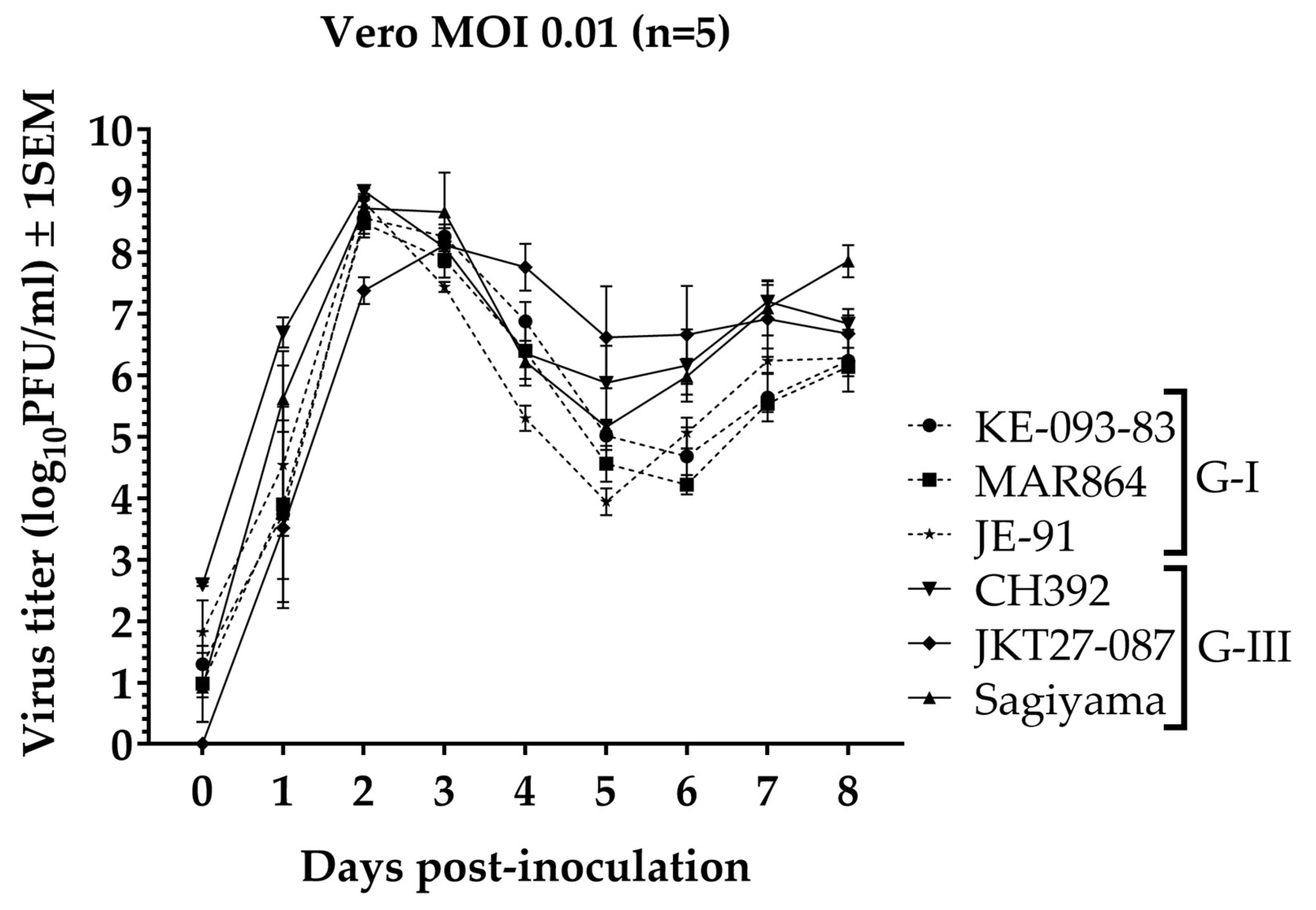
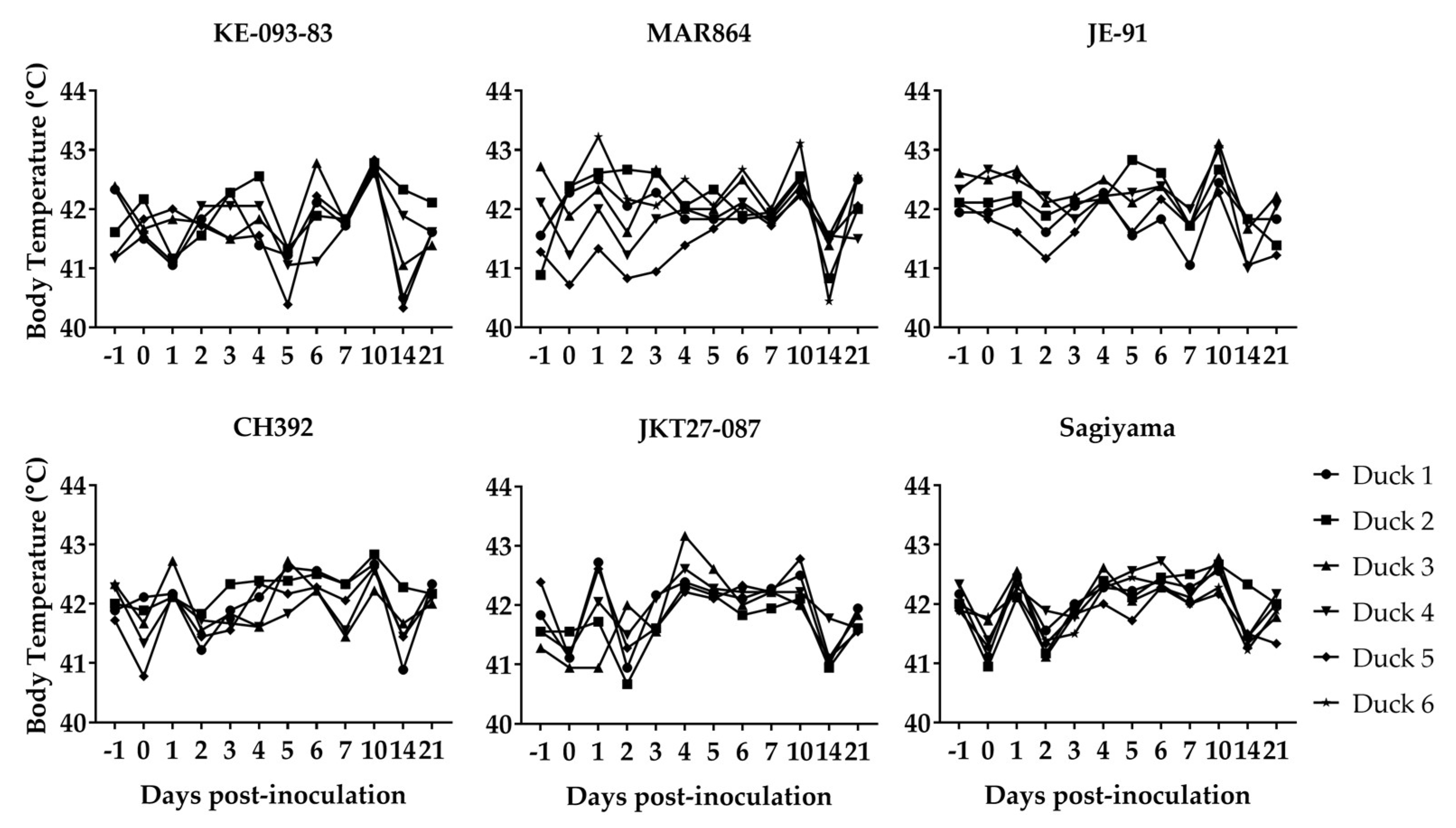
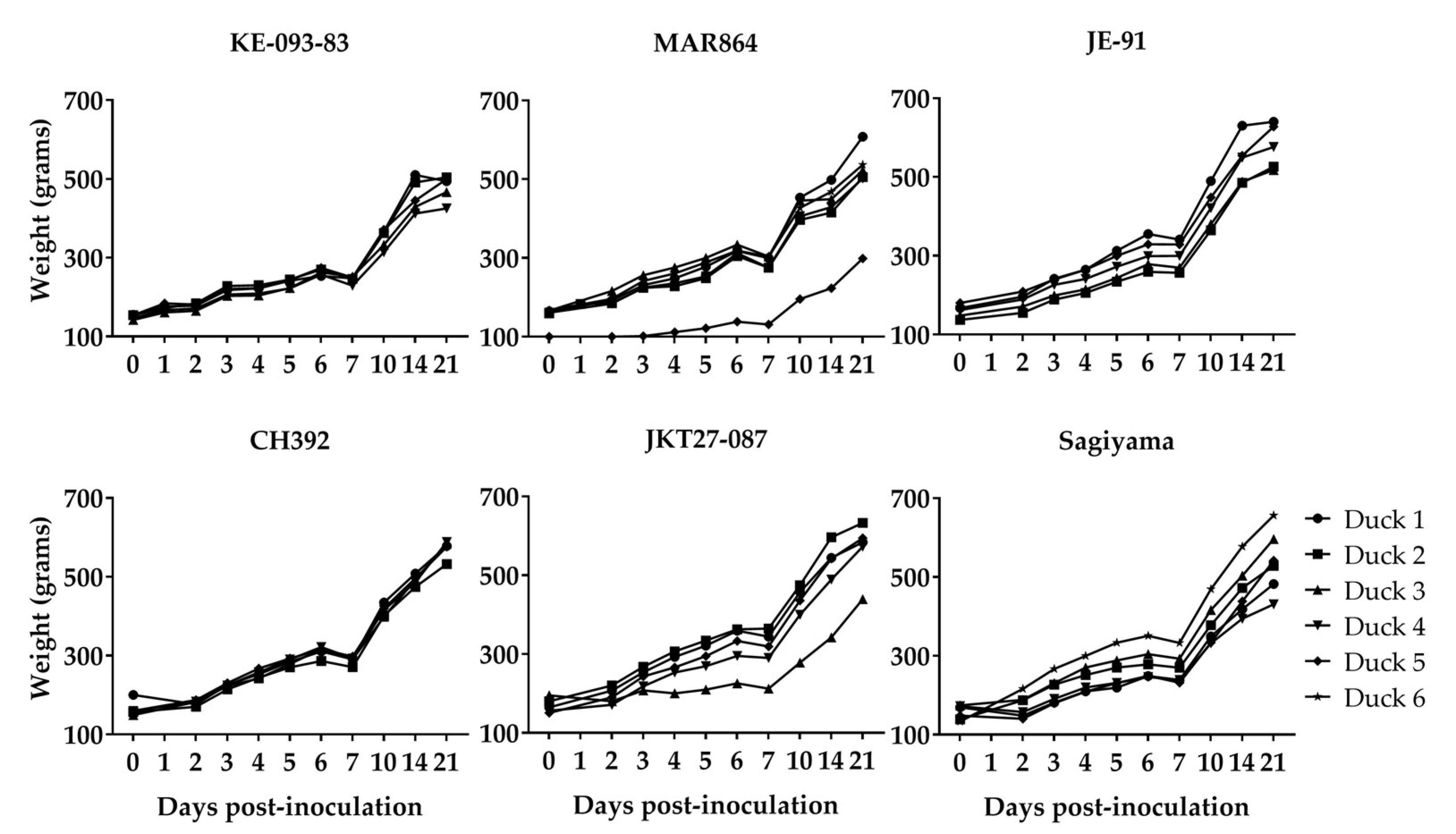
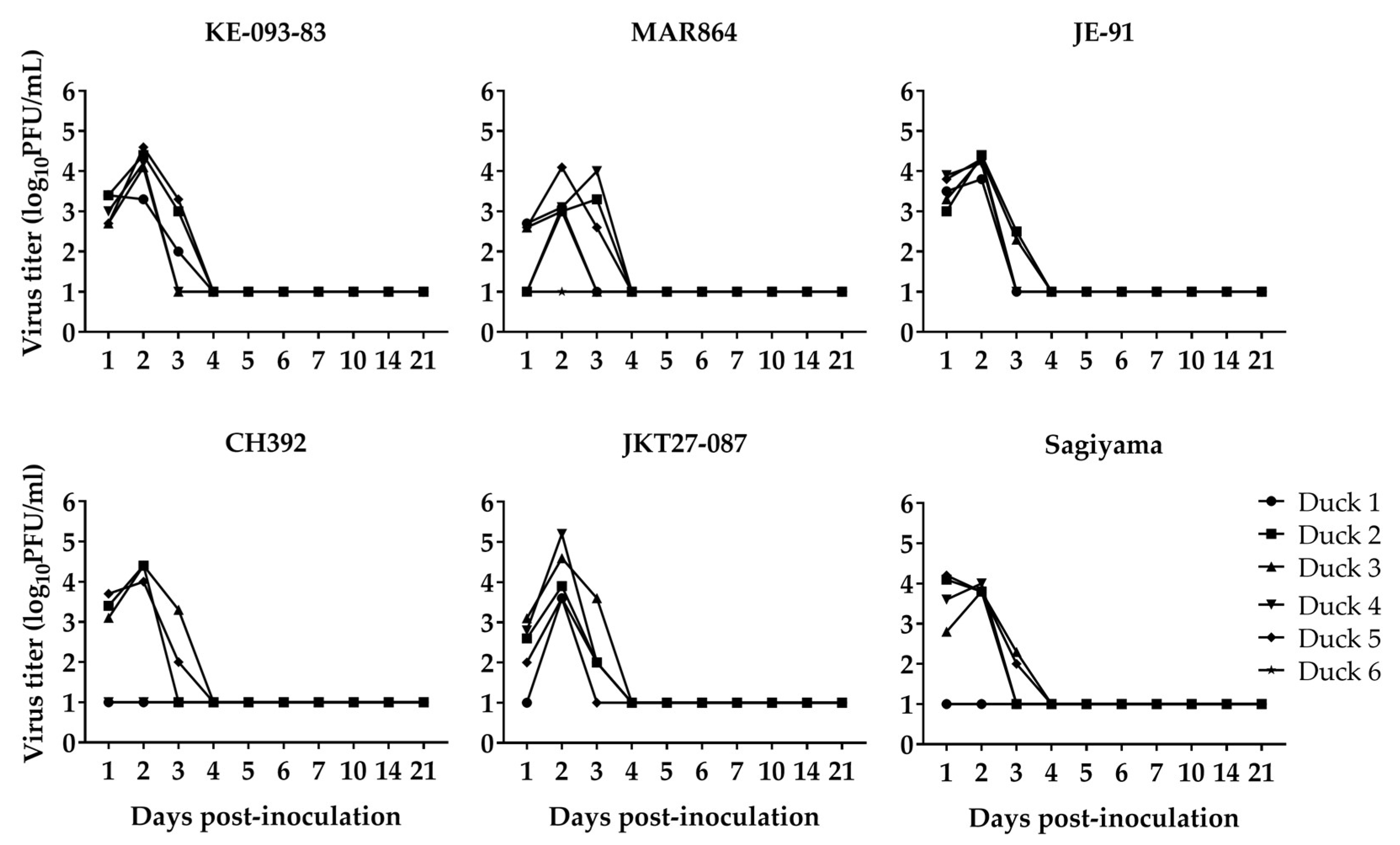
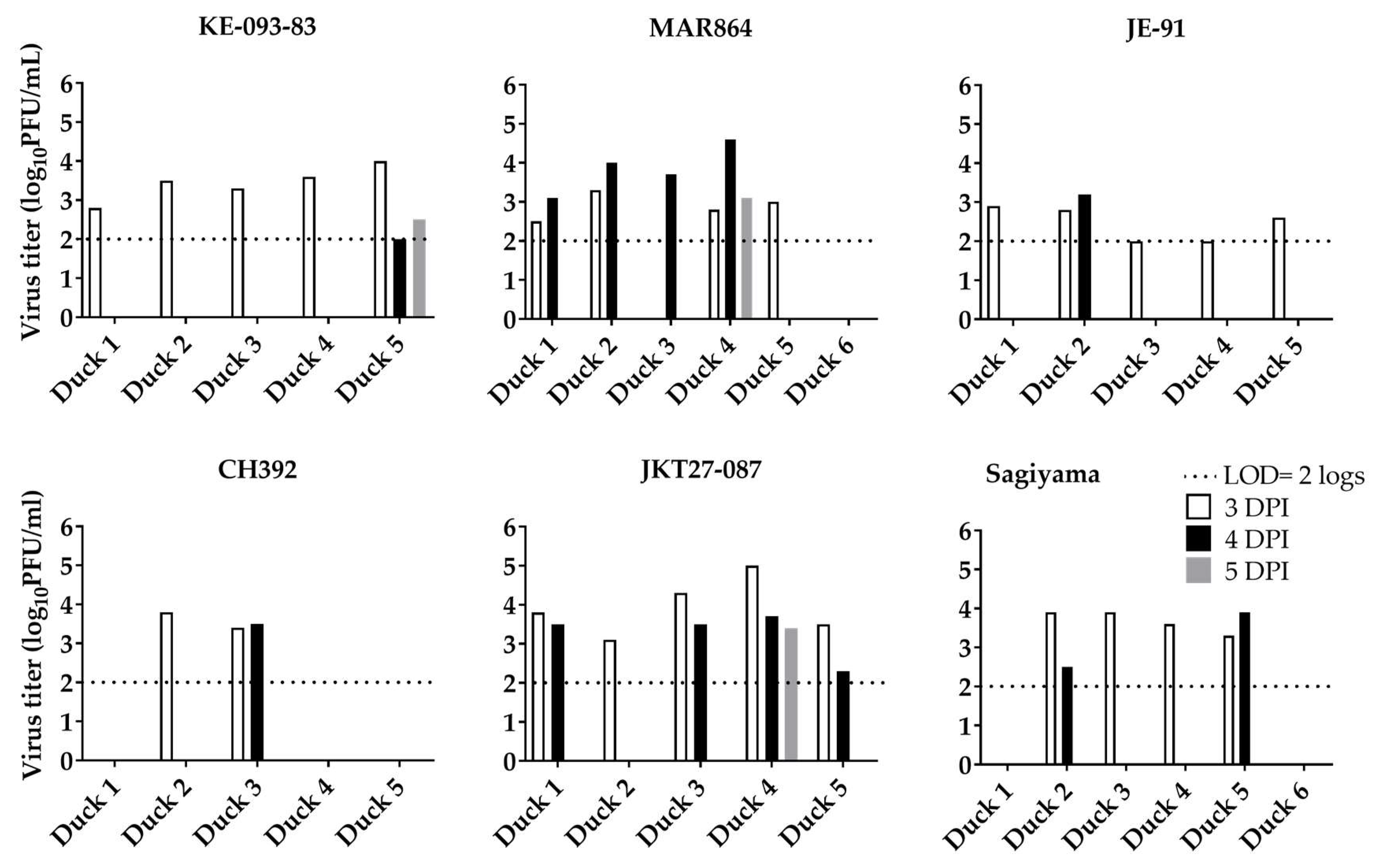
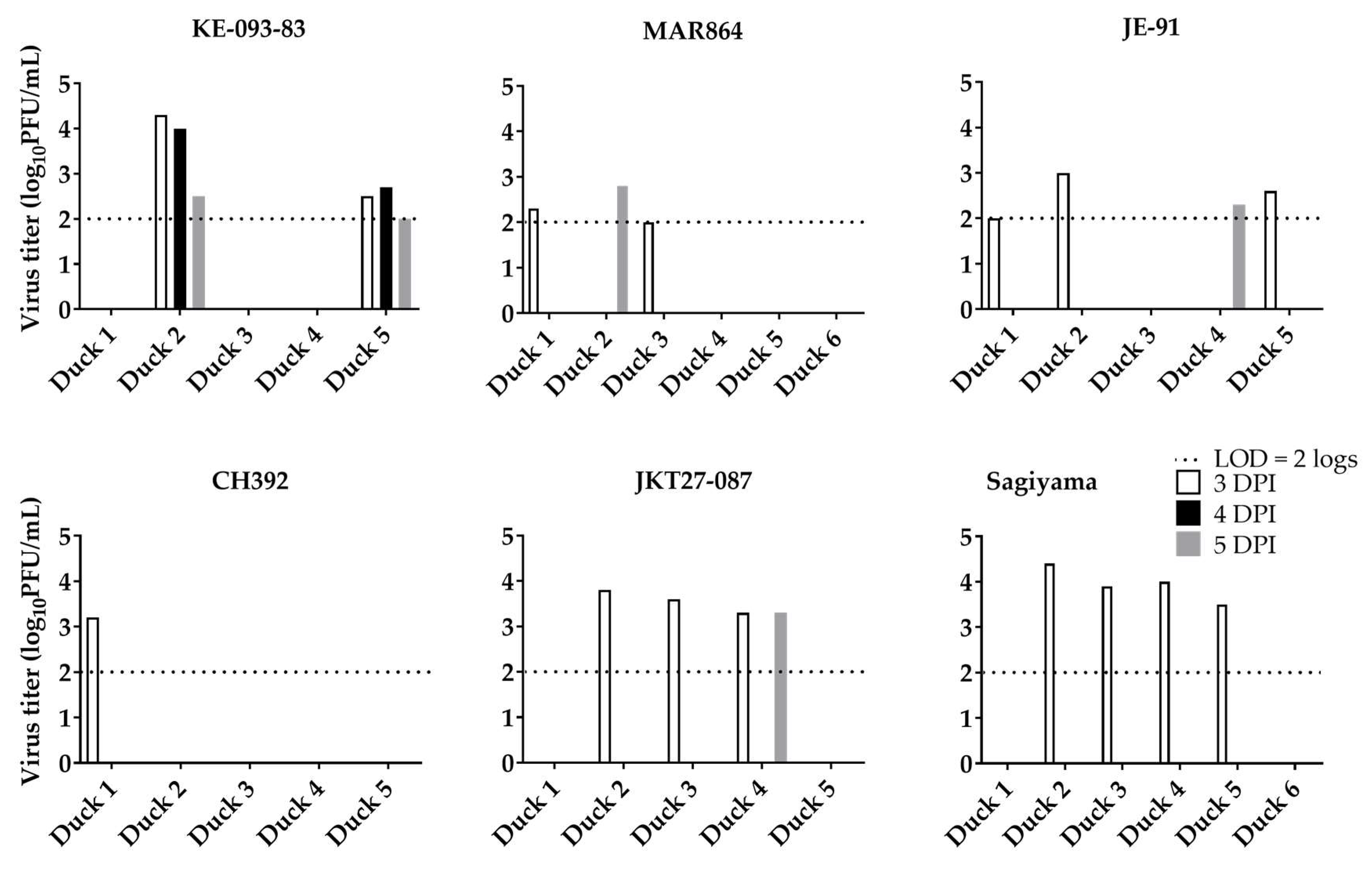
| Virus Strain (Genotype) | Source | Collection Year | Passage History | Country (Climate) | GenBank Accession # |
|---|---|---|---|---|---|
| KE-093-83 (G-I) | Mosquito | 1983 | Vero#1 | Thailand (Tropical) | KF192510 |
| MAR864 (G-I) | Cx. tritaeniorhynchus | 1967 | C6/36#1, Vero#1 | Cambodia (Tropical) | D00983 |
| JE-91 (G-I) | Cx. tritaeniorhynchus | 1991 | C6/36#1, Vero#1 | Korea (Temperate) | GQ415355 |
| CH392 (G-III) | Cx. tritaeniorhynchus | 1987 | Vero#1, C6/36#2 | Taiwan (Sub-tropical) | U44961 |
| JKT27-087 (GIII) | Mosquito | 1987 | C6/36#1 | Indonesia (Tropical) | JQ429308 |
| Sagiyama (G-III) | Cx. tritaeniorhynchus | 1957 | C6/36#1 | Japan (Temperate) | D00972 |
| G-I | G-III | ||||||||
|---|---|---|---|---|---|---|---|---|---|
| Virus | Duck | 0 dpi | 7 dpi | 21 dpi | Virus | Duck | 0 dpi | 7 dpi | 21 dpi |
| KE-093-83 | D1 | <10 | 40 | 320 | CH391 | D1 | <10 | <10 | 80 |
| D2 | <10 | 20 | 320 | D2 | <10 | 40 | 160 | ||
| D3 | <10 | 40 | ≥640 | D3 | <10 | 40 | ≥320 | ||
| D4 | <10 | 20 | 80 | D4 | <10 | 160 | 160 | ||
| D5 | <10 | 80 | 320 | D5 | <10 | 40 | 80 | ||
| MAR864 | D1 | <10 | 160 | 160 | JKT27-087 | D1 | <10 | 40 | ≥320 |
| D2 | <10 | 40 | 80 | D2 | <10 | ≥320 | ≥320 | ||
| D3 | <10 | 20 | 160 | D3 | <10 | 80 | ≥320 | ||
| D4 | <10 | 10 | 160 | D4 | <10 | 20 | ≥320 | ||
| D5 | <10 | 20 | 160 | D5 | <10 | 40 | 80 | ||
| Control | D6 | <10 | <10 | <10 | Sagiyama | D1 | <10 | 40 | 80 |
| JE-91 | D1 | <10 | 40 | 160 | D2 | <10 | 20 | ≥320 | |
| D2 | <10 | 80 | 80 | D3 | <10 | 80 | ≥320 | ||
| D3 | <10 | 80 | 320 | D4 | <10 | 160 | 80 | ||
| D4 | <10 | 80 | 80 | D5 | <10 | 40 | 160 | ||
| D5 | <10 | 80 | 160 | Control | D6 | <10 | <10 | <10 | |
| Strain | Genotype | Type | PFU/mL | Log10PFU/mL |
|---|---|---|---|---|
| KE-093-83 | I | Fresh harvest | 4,100,000 | 6.6 |
| Blood meal (1:1) | 750,000 | 5.9 | ||
| MAR864 | I | Fresh harvest | 1,300,000 | 6.1 |
| Blood meal (1:1) | 390,000 | 5.6 | ||
| JE-91 | I | Fresh harvest | 1,400,000 | 6.1 |
| Blood meal (1:1) | 320,000 | 5.5 | ||
| CH392 | III | Fresh harvest | 100,000 | 6.0 |
| Blood meal (1:1) | 350,000 | 5.5 | ||
| JKT27-087 | III | Fresh harvest | 450,000 | 5.7 |
| Blood meal (1:1) | 140,000 | 5.1 | ||
| Sagiyama | III | Fresh harvest | 1,200,000 | 6.1 |
| Blood meal (1:1) | 1,000,000 | 6.0 |
| Virus strain | Genotype | DPF | Infection (%) | Dissemination (%) | Transmission (%) |
|---|---|---|---|---|---|
| KE-093-83 | G-I | 7 | 56/60 (93.3%) | 18/60 (30%) | 1/60 (1.6%) |
| 14 | 47/60 (78.3%) | 33/60 (55%) | 4/60 (6.6%) | ||
| MAR864 | G-I | 7 | 56/60 (93.3%) | 21/60 (35%) | 8/60 (13.3%) |
| 14 | 49/60 (81.6%) | 11/60 (18.3%) | 5/60 (8.3%) | ||
| JE-91 | G-I | 7 | 47/60 (78.3%) | 26/60 (43.3%) | 3/60 (5%) |
| 14 | 58/60 (96.6%) | 43/60 (71.6%) | 11/60 (18.3%) | ||
| CH392 | G-III | 7 | 24/60 (40%) | 15/60 (25%) | 0/60 (0%) |
| 14 | 13/60 (21.6%) | 10/60 (16.6%) | 3/60 (5%) | ||
| JKT27-087 | G-III | 7 | 35/60 (58.3%) | 5/60 (8.3%) | 0/60 (0%) |
| 14 | 42/60 (70%) | 7/60 (11.6%) | 2/60 (3.3%) | ||
| Sagiyama | G-III | 7 | 32/60 (53.3%) | 19/60 (31.6%) | 0/60 (0%) |
| 14 | 51/60 (85%) | 13/60 (21.6%) | 4/60 (6.6%) |
© 2019 by the authors. Licensee MDPI, Basel, Switzerland. This article is an open access article distributed under the terms and conditions of the Creative Commons Attribution (CC BY) license (http://creativecommons.org/licenses/by/4.0/).
Share and Cite
Karna, A.K.; Bowen, R.A. Experimental Evaluation of the Role of Ecologically-Relevant Hosts and Vectors in Japanese Encephalitis Virus Genotype Displacement. Viruses 2019, 11, 32. https://doi.org/10.3390/v11010032
Karna AK, Bowen RA. Experimental Evaluation of the Role of Ecologically-Relevant Hosts and Vectors in Japanese Encephalitis Virus Genotype Displacement. Viruses. 2019; 11(1):32. https://doi.org/10.3390/v11010032
Chicago/Turabian StyleKarna, Ajit K., and Richard A. Bowen. 2019. "Experimental Evaluation of the Role of Ecologically-Relevant Hosts and Vectors in Japanese Encephalitis Virus Genotype Displacement" Viruses 11, no. 1: 32. https://doi.org/10.3390/v11010032
APA StyleKarna, A. K., & Bowen, R. A. (2019). Experimental Evaluation of the Role of Ecologically-Relevant Hosts and Vectors in Japanese Encephalitis Virus Genotype Displacement. Viruses, 11(1), 32. https://doi.org/10.3390/v11010032





